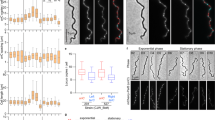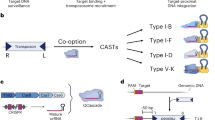Abstract
THE genomes of E. coli and some of its plasmids contain a class of elements called insertion sequences (IS)1–5. These elements exhibit various properties associated with modulation and alteration of gene expression. IS1 (length 800 nucleotide pairs2,3,) apparently plays a role in the amplification of resistance determinants in drug resistance factors5,6 and also causes polar insertion mutations2,3. IS2 (length 1,400 nucleotide pairs2) behaves as a controlling element, which can turn gene expression on or off7. IS3 (length 1,400 nucleotide pairs3) has been associated with strong polar mutations, and is a constituent of a transposable drug resistance determinant8. IS2 and IS3 have also been shown to specify integration loci for the fertility plasmid F4,9,10. Hybridisation data have allowed estimation of the number of IS1 and IS2 elements in the E. coli genome1, but except for the region around lac and purE, little is known about their natural location in the genome.
This is a preview of subscription content, access via your institution
Access options
Subscribe to this journal
Receive 51 print issues and online access
$199.00 per year
only $3.90 per issue
Buy this article
- Purchase on Springer Link
- Instant access to full article PDF
Prices may be subject to local taxes which are calculated during checkout
Similar content being viewed by others
References
Saedler, H., and Heiss, B., Molec. gen. Genet, 122, 267–277 (1973).
Hirsch, H. J., Starlinger, P., and Brachet, P., Molec. gen. Genet., 119, 191–206 (1972).
Fiandt, M., Szybalski, W., and Malamy, M. H., Molec. gen. Genet., 119, 233–231 (1972).
Davidson, N., Deonier, R. C., Hu, S., and Ohtsubo, E., in Microbiology 1974 (edit. by Schlessinger, D.), 56–65 (American Society for Microbiology, Washington, DC, 1975).
Hu, S., Ohtsubo, E., Davidson, N., and Saedler, H., J. Bact., 122, 764–774 (1975).
Ptashne, K., and Cohen, S. N., J. Bact., 122, 776–781 (1975).
Saedler, H., Reif, H. J., Hu, S., and Davidson, N., Molec. gen. Genet., 132, 265–289 (1974).
Kleckner, N., Chan, R. K., Tye, B.-K., and Botstein, D., J. molec. Biol., 97, 561–575 (1975).
Hu, S., Ohtsubo, E., and Davidson, N., J. Bact., 122, 749–763 (1975).
Deonier, R. C., and Davidson, N., J. molec. Biol. (in the press).
Berg, D. E., Davies, J., Allet, B., and Rochaix, J.-D., Proc. natn. Acad. Sci. U.S.A., 72, 3628–3632 (1975).
Heffron, F., Rubens, C., and Falkow, S., Proc. natn. Acad. Sci. U.S.A., 72, 3623–3627 (1975).
Bachmann, B., Bact. Rev., 36, 525–557 (1972).
Hu, S., Ptashne, K., Cohen, S. N., and Davidson, N., J. Bact., 123, 687–692 (1975).
Worcel, A., and Burgi, E., J. molec. Biol., 71, 127–147 (1972).
Ohtsubo, E., Deonier, R. C., Lee, H. J., and Davidson, N., J. molec. Biol., 89, 565–584 (1974).
Author information
Authors and Affiliations
Rights and permissions
About this article
Cite this article
DEONIER, R., HADLEY, R. Distribution of inverted IS-length sequences in the E. coli K12 genome. Nature 264, 191–193 (1976). https://doi.org/10.1038/264191a0
Received:
Accepted:
Issue Date:
DOI: https://doi.org/10.1038/264191a0
This article is cited by
Comments
By submitting a comment you agree to abide by our Terms and Community Guidelines. If you find something abusive or that does not comply with our terms or guidelines please flag it as inappropriate.



